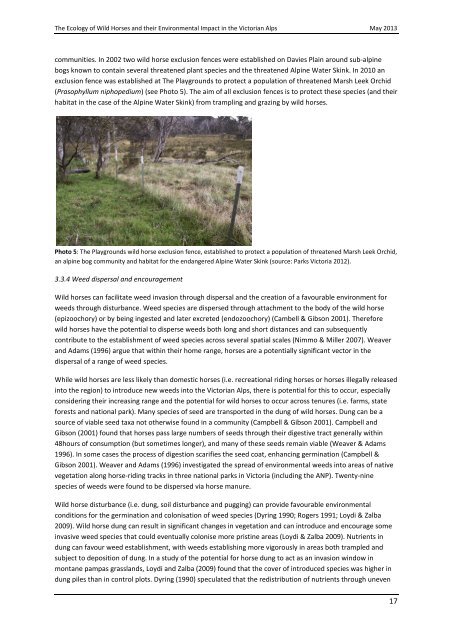The Ecology of Wild Horses and their Environmental ... - Parks Victoria
The Ecology of Wild Horses and their Environmental ... - Parks Victoria
The Ecology of Wild Horses and their Environmental ... - Parks Victoria
Create successful ePaper yourself
Turn your PDF publications into a flip-book with our unique Google optimized e-Paper software.
<strong>The</strong> <strong>Ecology</strong> <strong>of</strong> <strong>Wild</strong> <strong>Horses</strong> <strong>and</strong> <strong>their</strong> <strong>Environmental</strong> Impact in the <strong>Victoria</strong>n Alps May 2013communities. In 2002 two wild horse exclusion fences were established on Davies Plain around sub-alpinebogs known to contain several threatened plant species <strong>and</strong> the threatened Alpine Water Skink. In 2010 anexclusion fence was established at <strong>The</strong> Playgrounds to protect a population <strong>of</strong> threatened Marsh Leek Orchid(Prasophyllum niphopedium) (see Photo 5). <strong>The</strong> aim <strong>of</strong> all exclusion fences is to protect these species (<strong>and</strong> <strong>their</strong>habitat in the case <strong>of</strong> the Alpine Water Skink) from trampling <strong>and</strong> grazing by wild horses.Photo 5: <strong>The</strong> Playgrounds wild horse exclusion fence, established to protect a population <strong>of</strong> threatened Marsh Leek Orchid,an alpine bog community <strong>and</strong> habitat for the endangered Alpine Water Skink (source: <strong>Parks</strong> <strong>Victoria</strong> 2012).3.3.4 Weed dispersal <strong>and</strong> encouragement<strong>Wild</strong> horses can facilitate weed invasion through dispersal <strong>and</strong> the creation <strong>of</strong> a favourable environment forweeds through disturbance. Weed species are dispersed through attachment to the body <strong>of</strong> the wild horse(epizoochory) or by being ingested <strong>and</strong> later excreted (endozoochory) (Cambell & Gibson 2001). <strong>The</strong>reforewild horses have the potential to disperse weeds both long <strong>and</strong> short distances <strong>and</strong> can subsequentlycontribute to the establishment <strong>of</strong> weed species across several spatial scales (Nimmo & Miller 2007). Weaver<strong>and</strong> Adams (1996) argue that within <strong>their</strong> home range, horses are a potentially significant vector in thedispersal <strong>of</strong> a range <strong>of</strong> weed species.While wild horses are less likely than domestic horses (i.e. recreational riding horses or horses illegally releasedinto the region) to introduce new weeds into the <strong>Victoria</strong>n Alps, there is potential for this to occur, especiallyconsidering <strong>their</strong> increasing range <strong>and</strong> the potential for wild horses to occur across tenures (i.e. farms, stateforests <strong>and</strong> national park). Many species <strong>of</strong> seed are transported in the dung <strong>of</strong> wild horses. Dung can be asource <strong>of</strong> viable seed taxa not otherwise found in a community (Campbell & Gibson 2001). Campbell <strong>and</strong>Gibson (2001) found that horses pass large numbers <strong>of</strong> seeds through <strong>their</strong> digestive tract generally within48hours <strong>of</strong> consumption (but sometimes longer), <strong>and</strong> many <strong>of</strong> these seeds remain viable (Weaver & Adams1996). In some cases the process <strong>of</strong> digestion scarifies the seed coat, enhancing germination (Campbell &Gibson 2001). Weaver <strong>and</strong> Adams (1996) investigated the spread <strong>of</strong> environmental weeds into areas <strong>of</strong> nativevegetation along horse-riding tracks in three national parks in <strong>Victoria</strong> (including the ANP). Twenty-ninespecies <strong>of</strong> weeds were found to be dispersed via horse manure.<strong>Wild</strong> horse disturbance (i.e. dung, soil disturbance <strong>and</strong> pugging) can provide favourable environmentalconditions for the germination <strong>and</strong> colonisation <strong>of</strong> weed species (Dyring 1990; Rogers 1991; Loydi & Zalba2009). <strong>Wild</strong> horse dung can result in significant changes in vegetation <strong>and</strong> can introduce <strong>and</strong> encourage someinvasive weed species that could eventually colonise more pristine areas (Loydi & Zalba 2009). Nutrients indung can favour weed establishment, with weeds establishing more vigorously in areas both trampled <strong>and</strong>subject to deposition <strong>of</strong> dung. In a study <strong>of</strong> the potential for horse dung to act as an invasion window inmontane pampas grassl<strong>and</strong>s, Loydi <strong>and</strong> Zalba (2009) found that the cover <strong>of</strong> introduced species was higher indung piles than in control plots. Dyring (1990) speculated that the redistribution <strong>of</strong> nutrients through uneven17
















